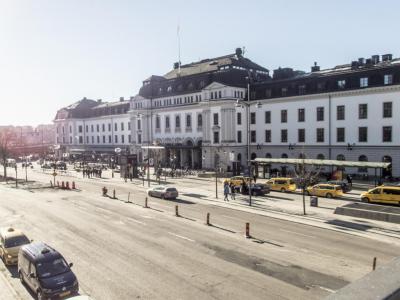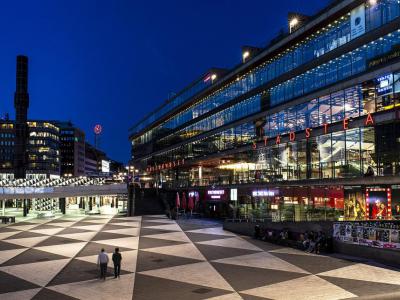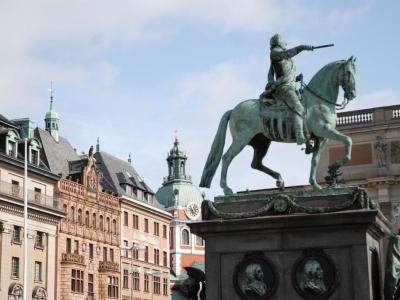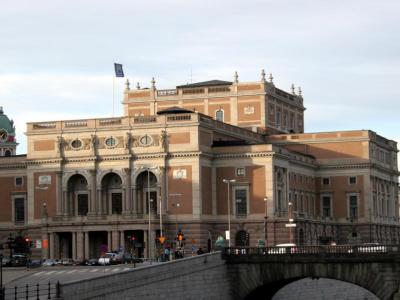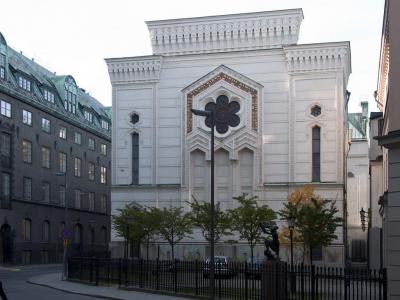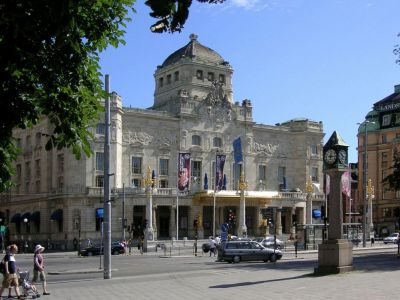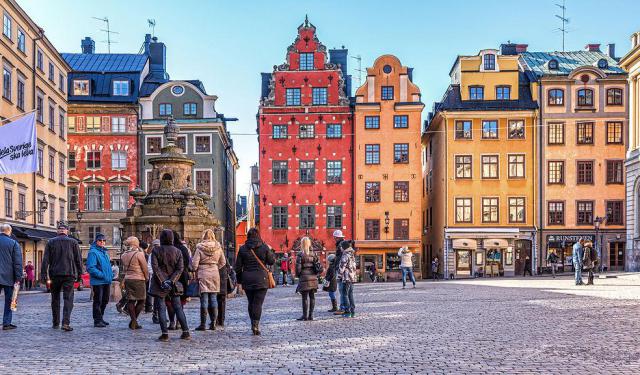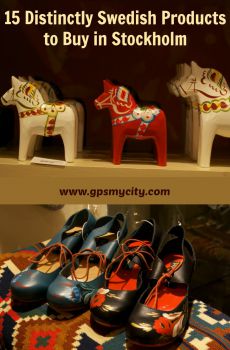
City Center (Norrmalm) Walk (Self Guided), Stockholm
Once an independent town, Norrmalm has been integral to Stockholm since 1635. As one of the city's central neighborhoods, it saw many old buildings torn down during the 1950s and 60s to clear space for new construction. Still, the most notable pieces of local architecture – featuring a wide range of styles, from Late Gothic to Renaissance and Baroque – are still in place and make Norrmalm a vibrant hub that encapsulates the essence of the Swedish capital.
Perhaps the best starting point for exploring Norrmalm is the Stockholm Central Station, a bustling transportation hub connecting the city to various destinations across the country and beyond. Adjacent to it is the elegant Saint Clare Church (Klara Kyrka), a striking landmark, whose Baroque architecture adds a touch of historical charm to the area.
Not far away, the modern House of Culture (Kulturhuset) offers a plethora of artistic and intellectual activities for locals and visitors to engage in.
Gustav Adolfs Torg, a lively square, serves as a gathering place for events and festivities, surrounded by cafes and shops buzzing with activity. Nearby, the Royal Swedish Opera and the Royal Dramatic Theatre are premier destinations for aficionados of the performing arts, showcasing world-class productions in magnificent settings.
Meanwhile, Saint James's Church (Sankt Jacobs Kyrka) and the Stockholm Synagogue offer spiritual sanctuaries amidst the urban landscape.
History buffs will appreciate the Hallwyl Museum (Hallwylska Palatset) housed in a beautifully preserved palace providing a glimpse into the lavish lifestyle of the Swedish aristocracy. And for art enthusiasts, the National Museum of Fine Arts (Nationalmusee), showcases a rich collection of Swedish and international artworks spanning centuries.
In essence, Stockholm's Norrmalm is a captivating blend of tradition and modernity. From architectural marvels to artistic wonders, this vibrant district promises an unforgettable experience for all who venture into its midst. So, whenever you're in Stockholm, plan a visit to Norrmalm and discover the treasures awaiting in the heart of the Swedish capital!
Perhaps the best starting point for exploring Norrmalm is the Stockholm Central Station, a bustling transportation hub connecting the city to various destinations across the country and beyond. Adjacent to it is the elegant Saint Clare Church (Klara Kyrka), a striking landmark, whose Baroque architecture adds a touch of historical charm to the area.
Not far away, the modern House of Culture (Kulturhuset) offers a plethora of artistic and intellectual activities for locals and visitors to engage in.
Gustav Adolfs Torg, a lively square, serves as a gathering place for events and festivities, surrounded by cafes and shops buzzing with activity. Nearby, the Royal Swedish Opera and the Royal Dramatic Theatre are premier destinations for aficionados of the performing arts, showcasing world-class productions in magnificent settings.
Meanwhile, Saint James's Church (Sankt Jacobs Kyrka) and the Stockholm Synagogue offer spiritual sanctuaries amidst the urban landscape.
History buffs will appreciate the Hallwyl Museum (Hallwylska Palatset) housed in a beautifully preserved palace providing a glimpse into the lavish lifestyle of the Swedish aristocracy. And for art enthusiasts, the National Museum of Fine Arts (Nationalmusee), showcases a rich collection of Swedish and international artworks spanning centuries.
In essence, Stockholm's Norrmalm is a captivating blend of tradition and modernity. From architectural marvels to artistic wonders, this vibrant district promises an unforgettable experience for all who venture into its midst. So, whenever you're in Stockholm, plan a visit to Norrmalm and discover the treasures awaiting in the heart of the Swedish capital!
How it works: Download the app "GPSmyCity: Walks in 1K+ Cities" from Apple App Store or Google Play Store to your mobile phone or tablet. The app turns your mobile device into a personal tour guide and its built-in GPS navigation functions guide you from one tour stop to next. The app works offline, so no data plan is needed when traveling abroad.
City Center (Norrmalm) Walk Map
Guide Name: City Center (Norrmalm) Walk
Guide Location: Sweden » Stockholm (See other walking tours in Stockholm)
Guide Type: Self-guided Walking Tour (Sightseeing)
# of Attractions: 10
Tour Duration: 2 Hour(s)
Travel Distance: 3.0 Km or 1.9 Miles
Author: rose
Sight(s) Featured in This Guide:
Guide Location: Sweden » Stockholm (See other walking tours in Stockholm)
Guide Type: Self-guided Walking Tour (Sightseeing)
# of Attractions: 10
Tour Duration: 2 Hour(s)
Travel Distance: 3.0 Km or 1.9 Miles
Author: rose
Sight(s) Featured in This Guide:
- Stockholm Central Station
- Klara Kyrka (Saint Clare Church)
- Kulturhuset (House of Culture)
- Gustav Adolfs Torg (Square)
- Royal Swedish Opera
- Sankt Jacobs Kyrka (Saint James's Church)
- Stockholm Synagogue
- Hallwylska Palatset (Hallwyl Palace)
- Royal Dramatic Theatre
- Nationalmuseet (National Museum of Fine Arts)
1) Stockholm Central Station
Stockholm Central Station is the primary railway station in Stockholm and one of the most significant transport hubs in Scandinavia. Designed by architect Adolf W. Edelsvärd, the station was constructed between 1867 and 1871, officially opening on 18 July 1871. For many years, it has been a bustling center, serving over 200,000 visitors daily, including nearly 170,000 travelers.
The station has seen several major renovations. Originally, tracks ran directly into the station, but between 1925 and 1927, they were redirected west. The former track hall was converted into a grand waiting hall, and the station was extended south, where a new pavilion was added. This area now serves as a conference facility next to the Royal waiting hall used by the Swedish Royal Family.
The facade of the station along Vasagatan was simplified in 1951, and in 1958, an underground passage was added, connecting the station to T-Centralen, Stockholm's central metro hub. A unique feature of the station is "Ringen" ("the ring"), a distinctive circular area in the center of the ground floor, humorously nicknamed "spottkoppen" ("the spittoon") by locals.
In the 21st century, the station has embraced modern technology and sustainability initiatives. Notably, in 2011, Jernhusen, the real estate company managing the station, devised an innovative system to capture and use the body heat generated by the thousands of commuters passing through the station daily to warm a nearby building.
The station's front facade was renovated in the summer of 2012, during which a statue of Nils Ericson, a prominent Swedish mechanical engineer and railway builder, was humorously fitted with ear mufflers, accompanied by the text "Oh my gosh, what a noise" ("Jäsicken hvilket oväsen" ), adding a touch of whimsy to this historic site.
The station has seen several major renovations. Originally, tracks ran directly into the station, but between 1925 and 1927, they were redirected west. The former track hall was converted into a grand waiting hall, and the station was extended south, where a new pavilion was added. This area now serves as a conference facility next to the Royal waiting hall used by the Swedish Royal Family.
The facade of the station along Vasagatan was simplified in 1951, and in 1958, an underground passage was added, connecting the station to T-Centralen, Stockholm's central metro hub. A unique feature of the station is "Ringen" ("the ring"), a distinctive circular area in the center of the ground floor, humorously nicknamed "spottkoppen" ("the spittoon") by locals.
In the 21st century, the station has embraced modern technology and sustainability initiatives. Notably, in 2011, Jernhusen, the real estate company managing the station, devised an innovative system to capture and use the body heat generated by the thousands of commuters passing through the station daily to warm a nearby building.
The station's front facade was renovated in the summer of 2012, during which a statue of Nils Ericson, a prominent Swedish mechanical engineer and railway builder, was humorously fitted with ear mufflers, accompanied by the text "Oh my gosh, what a noise" ("Jäsicken hvilket oväsen" ), adding a touch of whimsy to this historic site.
2) Klara Kyrka (Saint Clare Church)
Church of Saint Clare (Klara Kyrka) is a historically significant church in the Klara area of lower Norrmalm, Stockholm. The church traces its origins back to the 1280s when it was initially part of a Roman Catholic convent dedicated to Saint Clare. This convent, from which both the church and the surrounding Klarakvarteren district derive their names, was a prosperous institution for several centuries. However, by the 15th century, the convent began to decline, leading to its eventual disrepair.
In 1527, during the Protestant Reformation under King Gustav Vasa, both the original church and the convent, which had already fallen into ruin, were demolished. The construction of the current church structure began in 1572, initiated by King Johan III.
Over the years, the Church of Saint Clare has faced significant challenges, including a devastating fire in the mid-18th century that led to its destruction. The church was subsequently rebuilt, and throughout the 19th century, it underwent extensive renovations. These renovations not only restored the church but also transformed its interior, endowing it with a distinctive 18th-century aesthetic characterized by golden tones, warm hues, and elegant stained glass, as well as a magnificent gold pulpit.
The church's exterior, particularly its 116-meter (381 feet) tall tower, is largely a product of 19th-century restoration efforts. This tower, completed in the 1880s, remains one of the church's most prominent features. The churchyard, established in the 17th century, is the final resting place of notable figures, including the renowned poet Carl Michael Bellman.
Today, the Church of Saint Clare stands surrounded by modern buildings, with its tall spire being one of the few visible reminders of its historical presence in the area. Despite the changes in its surroundings, the church continues to be a significant historical and architectural landmark in Stockholm.
In 1527, during the Protestant Reformation under King Gustav Vasa, both the original church and the convent, which had already fallen into ruin, were demolished. The construction of the current church structure began in 1572, initiated by King Johan III.
Over the years, the Church of Saint Clare has faced significant challenges, including a devastating fire in the mid-18th century that led to its destruction. The church was subsequently rebuilt, and throughout the 19th century, it underwent extensive renovations. These renovations not only restored the church but also transformed its interior, endowing it with a distinctive 18th-century aesthetic characterized by golden tones, warm hues, and elegant stained glass, as well as a magnificent gold pulpit.
The church's exterior, particularly its 116-meter (381 feet) tall tower, is largely a product of 19th-century restoration efforts. This tower, completed in the 1880s, remains one of the church's most prominent features. The churchyard, established in the 17th century, is the final resting place of notable figures, including the renowned poet Carl Michael Bellman.
Today, the Church of Saint Clare stands surrounded by modern buildings, with its tall spire being one of the few visible reminders of its historical presence in the area. Despite the changes in its surroundings, the church continues to be a significant historical and architectural landmark in Stockholm.
3) Kulturhuset (House of Culture)
Kulturhuset is a cultural center, one of the largest of its kind in Northern Europe. For several years before 1983, it had provided temporary accommodation to the Swedish Parliament whose own building was under construction. Designed as a public space for all people in Stockholm, Kulturhuset Stadsteatern is the brainchild of architect Peter Celsing who strove to create a space fit to accommodate all forms of art. The renowned architect won the competition for a new cultural center in 1966. The glass front of the building facing Sergels torg enhances the idea of a shared common space, and, at night, creates a transparent view into the interior.
There are eight stages at Kulturhuset Stadsteatern used annually for over 2,000 shows of performing arts, and attended by audience of more than half a million people. Since 2013, Kulturhuset Stadsteatern has had its own dance company in residence.
Kulturhuset Stadsteatern hosts about six curated art, design and fashion exhibitions annually, and has six profile libraries catering to different audiences, of which three have a children’s and youth perspective. The building also houses a theater, restaurants, shops, several cafes, a variety of entertainment facilities, plus a Tourist Center run by external partners.
Any given day, the house offers new paths into diversity, be it film or debate, an exhibition, dance or musical performance, or just finding that special book you always wanted but never thought existed.
There are eight stages at Kulturhuset Stadsteatern used annually for over 2,000 shows of performing arts, and attended by audience of more than half a million people. Since 2013, Kulturhuset Stadsteatern has had its own dance company in residence.
Kulturhuset Stadsteatern hosts about six curated art, design and fashion exhibitions annually, and has six profile libraries catering to different audiences, of which three have a children’s and youth perspective. The building also houses a theater, restaurants, shops, several cafes, a variety of entertainment facilities, plus a Tourist Center run by external partners.
Any given day, the house offers new paths into diversity, be it film or debate, an exhibition, dance or musical performance, or just finding that special book you always wanted but never thought existed.
4) Gustav Adolfs Torg (Square)
Gustav Adolfs Square is a significant historical and cultural landmark in Stockholm, situated in the Norrmalm district near the Norrbro bridge. This prominent square is located at the intersection of Strömgatan, Fredsgatan, Malmtorgsgatan, and Regeringsgatan streets, making it a central point in the city's layout.
The square is named after King Gustav II Adolf, a revered Swedish monarch who ruled from 1611 to 1632. Known as "the Lion of the North," Gustav II Adolf is remembered as a national hero, particularly for his military achievements. The square was named in his honor in 1805, and in the center of Gustav Adolfs Square stands a grand equestrian statue of the king. This statue, created by Pierre Hubert L'Archevêque, a French-born sculptor who became a Swedish citizen, was molded in 1778 and erected in 1791, making it the first equestrian statue ever installed in Sweden. The statue is guarded by two bronze lions, added in 1926, which are replicas of ancient sculptures dating back to the 300s, with the originals housed in the Vatican Museums in Rome.
Gustav Adolfs Square is not just a visual spectacle but also holds a unique place in Stockholm's geography. Unlike many other Swedish cities where distances are measured from railway or bus stations, Stockholm uses this square as the reference point for setting distances to and from the city. Surrounding the square are several important buildings, including the Royal Opera, and the Arvfurstens palats, which serve as the seat of the Ministry of Foreign Affairs, and the Ministry of Defence. Additionally, to the south of the square, one can find the Riksdag Building on Helgeandsholmen and the Royal Palace in Gamla Stan, further highlighting its central role in Stockholm's political and cultural landscape.
The square is named after King Gustav II Adolf, a revered Swedish monarch who ruled from 1611 to 1632. Known as "the Lion of the North," Gustav II Adolf is remembered as a national hero, particularly for his military achievements. The square was named in his honor in 1805, and in the center of Gustav Adolfs Square stands a grand equestrian statue of the king. This statue, created by Pierre Hubert L'Archevêque, a French-born sculptor who became a Swedish citizen, was molded in 1778 and erected in 1791, making it the first equestrian statue ever installed in Sweden. The statue is guarded by two bronze lions, added in 1926, which are replicas of ancient sculptures dating back to the 300s, with the originals housed in the Vatican Museums in Rome.
Gustav Adolfs Square is not just a visual spectacle but also holds a unique place in Stockholm's geography. Unlike many other Swedish cities where distances are measured from railway or bus stations, Stockholm uses this square as the reference point for setting distances to and from the city. Surrounding the square are several important buildings, including the Royal Opera, and the Arvfurstens palats, which serve as the seat of the Ministry of Foreign Affairs, and the Ministry of Defence. Additionally, to the south of the square, one can find the Riksdag Building on Helgeandsholmen and the Royal Palace in Gamla Stan, further highlighting its central role in Stockholm's political and cultural landscape.
5) Royal Swedish Opera
The Royal Swedish Opera, located in the heart of Stockholm, is a prestigious opera and ballet company with a rich history dating back to the 18th century. Situated in the Norrmalm district, the Opera House stands on the eastern side of Gustav Adolfs Torg, across from the former Arvfurstens Palats, now the Ministry for Foreign Affairs, and near other significant landmarks like the Royal Palace, Sager House, and the Riksdag building.
The opera company was founded by King Gustav III alongside the Royal Swedish Academy of Music. Its inaugural performance, Thetis and Phelée, took place on January 18, 1773, marking the first native-speaking opera performed in Sweden. However, the original opera house, commissioned by King Gustav III and designed by architect Carl Fredrik Adelcrantz, was not completed until 1782. This "Gustavian Opera" was an imposing structure featuring a Corinthian tetrastyle portico, a four-tiered auditorium, and a lavish neoclassical foyer. The building served as a cultural hub for over a century before being demolished in 1892 to make way for a new opera house.
The current Royal Opera House, designed by Axel Johan Anderberg, was inaugurated in 1897 by King Oscar II with a production of Franz Berwald's Estrella de Soria. This Neoclassical building, known simply as "Operan," features a grand, golden foyer (Guldfoajén) and a marble grand staircase leading to a three-tiered auditorium, which seats 1,200. While smaller than its predecessor, the new house maintains the grandeur and elegance befitting its royal patronage. The Royal Box, reserved for the Swedish Royal Family, is prominently located in the first tier above the orchestra pit.
The Royal Swedish Opera is renowned for its rich tradition of featuring world-class talent, including legendary singers like Jussi Björling, Birgit Nilsson, and Anne Sofie von Otter. The company performs a wide range of productions, mostly in their original languages with Swedish subtitles. The Royal Swedish Orchestra, or Kungliga Hovkapellet, is one of Europe's oldest orchestras, tracing its origins back to 1526.
Today, the Royal Swedish Opera continues to be a cornerstone of Sweden's cultural life, preserving and advancing the country's operatic and ballet traditions.
Why You Should Visit:
Beautiful inside and outside, this opera house is a gorgeously decorated edifice worth admiring by architecture lovers.
The actual stage and seating area are smaller than one might imagine, which makes for a very cozy and intimate setting.
The operas played here are usually of very high quality.
Tip:
You can well purchase your tickets for performances online, as the schedule is published for the whole season.
By taking a guided tour, you will have the opportunity to look backstage, visit the Royal Box, and look into the orchestra pit.
The opera company was founded by King Gustav III alongside the Royal Swedish Academy of Music. Its inaugural performance, Thetis and Phelée, took place on January 18, 1773, marking the first native-speaking opera performed in Sweden. However, the original opera house, commissioned by King Gustav III and designed by architect Carl Fredrik Adelcrantz, was not completed until 1782. This "Gustavian Opera" was an imposing structure featuring a Corinthian tetrastyle portico, a four-tiered auditorium, and a lavish neoclassical foyer. The building served as a cultural hub for over a century before being demolished in 1892 to make way for a new opera house.
The current Royal Opera House, designed by Axel Johan Anderberg, was inaugurated in 1897 by King Oscar II with a production of Franz Berwald's Estrella de Soria. This Neoclassical building, known simply as "Operan," features a grand, golden foyer (Guldfoajén) and a marble grand staircase leading to a three-tiered auditorium, which seats 1,200. While smaller than its predecessor, the new house maintains the grandeur and elegance befitting its royal patronage. The Royal Box, reserved for the Swedish Royal Family, is prominently located in the first tier above the orchestra pit.
The Royal Swedish Opera is renowned for its rich tradition of featuring world-class talent, including legendary singers like Jussi Björling, Birgit Nilsson, and Anne Sofie von Otter. The company performs a wide range of productions, mostly in their original languages with Swedish subtitles. The Royal Swedish Orchestra, or Kungliga Hovkapellet, is one of Europe's oldest orchestras, tracing its origins back to 1526.
Today, the Royal Swedish Opera continues to be a cornerstone of Sweden's cultural life, preserving and advancing the country's operatic and ballet traditions.
Why You Should Visit:
Beautiful inside and outside, this opera house is a gorgeously decorated edifice worth admiring by architecture lovers.
The actual stage and seating area are smaller than one might imagine, which makes for a very cozy and intimate setting.
The operas played here are usually of very high quality.
Tip:
You can well purchase your tickets for performances online, as the schedule is published for the whole season.
By taking a guided tour, you will have the opportunity to look backstage, visit the Royal Box, and look into the orchestra pit.
6) Sankt Jacobs Kyrka (Saint James's Church)
Saint James's Church (Sankt Jacobs Kyrka) is one of Stockholm's most centrally located and historically significant churches. Dedicated to Saint James the Greater, the patron saint of travelers, it is often mistakenly referred to as Saint Jacob's due to the linguistic overlap in Swedish between the names James and Jacob.
The church is surrounded by prominent landmarks, including Kungsträdgården Park, the Royal Opera, and the Royal Palace, making it a key feature in the heart of the Swedish capital. A notable feature outside the church is a bust of the renowned Swedish tenor, Jussi Björling.
Construction of the church spanned several centuries, beginning in 1580 under the orders of King John III. This lengthy construction period resulted in an eclectic mix of architectural styles, including Late Gothic, Renaissance, and Baroque. The project saw contributions from numerous architects over the years, including Willem Boy, Hans Ferster, Göran Joshuae Adelcrantz, Carl Hårleman, Carl Möller, and Agi Lindegren.
The site itself has a history dating back to at least 1311 when it was part of the Solna parish. However, the original chapel was demolished by King Gustav Vasa during the Protestant Reformation in 1527. The current church structure began taking shape in 1588, and by the time of King John III's death, significant progress had been made on the central nave and aisles. The church was officially inaugurated on November 26, 1643, by Queen Christina, although the interior remained unfinished for many years.
The church has undergone numerous renovations and restorations throughout its history, including significant changes in the 19th century when much of the 17th-century interior was replaced, and the introduction of modern amenities such as gas lighting and central heating. A major restoration in 1910 added a new copper roof and sandstone base, contributing to the church's current appearance.
Today, Sankt Jacobs Kyrka stands as a testament to Stockholm's rich architectural and religious heritage, embodying the evolution of the city's cultural landscape over several centuries.
The church is surrounded by prominent landmarks, including Kungsträdgården Park, the Royal Opera, and the Royal Palace, making it a key feature in the heart of the Swedish capital. A notable feature outside the church is a bust of the renowned Swedish tenor, Jussi Björling.
Construction of the church spanned several centuries, beginning in 1580 under the orders of King John III. This lengthy construction period resulted in an eclectic mix of architectural styles, including Late Gothic, Renaissance, and Baroque. The project saw contributions from numerous architects over the years, including Willem Boy, Hans Ferster, Göran Joshuae Adelcrantz, Carl Hårleman, Carl Möller, and Agi Lindegren.
The site itself has a history dating back to at least 1311 when it was part of the Solna parish. However, the original chapel was demolished by King Gustav Vasa during the Protestant Reformation in 1527. The current church structure began taking shape in 1588, and by the time of King John III's death, significant progress had been made on the central nave and aisles. The church was officially inaugurated on November 26, 1643, by Queen Christina, although the interior remained unfinished for many years.
The church has undergone numerous renovations and restorations throughout its history, including significant changes in the 19th century when much of the 17th-century interior was replaced, and the introduction of modern amenities such as gas lighting and central heating. A major restoration in 1910 added a new copper roof and sandstone base, contributing to the church's current appearance.
Today, Sankt Jacobs Kyrka stands as a testament to Stockholm's rich architectural and religious heritage, embodying the evolution of the city's cultural landscape over several centuries.
7) Stockholm Synagogue
The Great Synagogue of Stockholm is a significant historical and architectural landmark in Sweden's capital. Constructed between 1867 and 1870, the synagogue was designed by the architect Fredrik Wilhelm Scholander, who envisioned the building as a "paraphrase over Oriental motifs." This design, characterized by its rectangular form and four towers—each containing a staircase—draws inspiration from the Biblical description of the ancient Temple of Jerusalem. The synagogue can accommodate up to 850 people, making it a central place of worship and gathering for Stockholm's Jewish community.
Beneath the synagogue lies the Jewish Community Library (Judiska Biblioteket). This library is home to a diverse collection of books in multiple languages, including Swedish, German, English, French, and Hebrew. It also houses the personal library of Rabbi Marcus Ehrenpreis, who served as Chief Rabbi of Sweden from 1914 to 1951. The library not only preserves these valuable texts but also hosts occasional exhibits and an annual series dedicated to the history of the Jewish people.
A poignant feature of the synagogue is the Holocaust Memorial, which is situated on the wall connecting the synagogue to the community hall. This memorial bears the names of over 8,000 Holocaust victims who were relatives of Swedish Jews. In 1998, King Carl XVI Gustav of Sweden officially dedicated the memorial, underscoring its national significance.
In 2017, a new mikvah, a ritual bath, was constructed in the synagogue's basement, further enhancing the building's religious facilities. The synagogue's interior is adorned with Hebrew inscriptions etched and painted into the stonework, adding to its spiritual and historical ambiance.
Recognized as one of Stockholm's most historic buildings, the Great Synagogue has been listed in the Swedish Registry of National Historical Buildings, reflecting its importance as a cultural and religious monument.
Beneath the synagogue lies the Jewish Community Library (Judiska Biblioteket). This library is home to a diverse collection of books in multiple languages, including Swedish, German, English, French, and Hebrew. It also houses the personal library of Rabbi Marcus Ehrenpreis, who served as Chief Rabbi of Sweden from 1914 to 1951. The library not only preserves these valuable texts but also hosts occasional exhibits and an annual series dedicated to the history of the Jewish people.
A poignant feature of the synagogue is the Holocaust Memorial, which is situated on the wall connecting the synagogue to the community hall. This memorial bears the names of over 8,000 Holocaust victims who were relatives of Swedish Jews. In 1998, King Carl XVI Gustav of Sweden officially dedicated the memorial, underscoring its national significance.
In 2017, a new mikvah, a ritual bath, was constructed in the synagogue's basement, further enhancing the building's religious facilities. The synagogue's interior is adorned with Hebrew inscriptions etched and painted into the stonework, adding to its spiritual and historical ambiance.
Recognized as one of Stockholm's most historic buildings, the Great Synagogue has been listed in the Swedish Registry of National Historical Buildings, reflecting its importance as a cultural and religious monument.
8) Hallwylska Palatset (Hallwyl Palace)
The Hallwyl Palace (Hallwylska Palatset) in Stockholm is a remarkable architectural and cultural landmark that reflects the opulence and grandeur of the late Victorian era. Constructed between 1893 and 1898, the palace was designed by renowned architect Isak Gustaf Clason for Count Walther von Hallwyl and his wife, Wilhelmina. The palace served not only as their winter residence but also as a space to house Count Walther's office and Countess Wilhelmina's extensive art collection, which she amassed during her worldwide travels with the intent of founding a museum.
Wilhelmina von Hallwyl's passion for art and culture led her to donate the palace to the Swedish State in 1920, under the condition that it would remain unchanged. This bequest made a decade before her death, ensured that the Hallwyl Palace would be preserved as a historical monument. The Hallwyl Museum (Hallwylska Museet) officially opened to the public in 1938, offering visitors a unique glimpse into the lifestyle of Stockholm's nobility at the turn of the 20th century.
The exterior of Hallwyl Palace is an architectural homage to history, featuring elements inspired by medieval and Renaissance styles, particularly from Venice. However, the interior of the building was state-of-the-art for its time, equipped with modern amenities such as electricity, central heating, telephones, and bathrooms. An elevator was later added to further modernize the palace.
The Hallwyl Collection now consists of approximately 50,000 works of art, preserved in the very setting designed to house them. The museum's well-preserved rooms offer an immersive experience, transporting visitors back to the grandeur of late 19th and early 20th-century aristocratic life in Sweden.
Wilhelmina von Hallwyl's passion for art and culture led her to donate the palace to the Swedish State in 1920, under the condition that it would remain unchanged. This bequest made a decade before her death, ensured that the Hallwyl Palace would be preserved as a historical monument. The Hallwyl Museum (Hallwylska Museet) officially opened to the public in 1938, offering visitors a unique glimpse into the lifestyle of Stockholm's nobility at the turn of the 20th century.
The exterior of Hallwyl Palace is an architectural homage to history, featuring elements inspired by medieval and Renaissance styles, particularly from Venice. However, the interior of the building was state-of-the-art for its time, equipped with modern amenities such as electricity, central heating, telephones, and bathrooms. An elevator was later added to further modernize the palace.
The Hallwyl Collection now consists of approximately 50,000 works of art, preserved in the very setting designed to house them. The museum's well-preserved rooms offer an immersive experience, transporting visitors back to the grandeur of late 19th and early 20th-century aristocratic life in Sweden.
9) Royal Dramatic Theatre
The Royal Dramatic Theatre (Dramaten) in Stockholm is the country's national stage for spoken drama, with a rich history dating back to its founding in 1788. As Sweden's premier venue for theatre, it stages around 1,000 performances annually across its seven stages, drawing audiences from around the world to experience its varied repertoire. This includes Swedish and international classics as well as contemporary works, reflecting its mission to nurture and promote the Swedish language and cultural heritage in theatre.
The theatre has been housed in its current location at Nybroplan in Stockholm since 1908, an Art Nouveau masterpiece designed by the architect Fredrik Lilljekvist. This grand building, made of white marble and adorned with gold details, is a stunning example of Jugendstil architecture. The interior is equally impressive, with decorations by renowned Swedish artists such as Carl Milles, Carl Larsson, and Prince Eugen. The Marble Foyer (Marmorsalen) and its adjacent terraces are particularly popular for visitors seeking to enjoy the theatre's cultured ambiance.
In addition to its role as a performance venue, the Royal Dramatic Theatre has been a significant contributor to the Swedish acting tradition through its Royal Dramatic Training Academy. This institution has produced many of Sweden's most famous actors and directors, including Greta Garbo, Ingrid Bergman, Max von Sydow, and Bibi Andersson. Although the academy became a separate institution in 1967, its legacy continues to be closely associated with the theatre.
The Royal Dramatic Theatre has always maintained close ties with the Swedish state, reflecting its origins during the reign of Gustav III. Since 1975, it has operated as a state-owned limited company, continuing its mission to be a central pillar of Swedish cultural life. Whether through guided tours that take visitors behind the scenes or the numerous performances that fill its stages each year, the Royal Dramatic Theatre remains a cultural jewel in Sweden's capital.
Tip:
Visitors should expect all productions to be in Swedish.
Guided tours are offered during the year; guests are advised to call in advance for reservations.
The English-guided tours are scheduled for Saturdays, usually at 5 pm.
The theatre has been housed in its current location at Nybroplan in Stockholm since 1908, an Art Nouveau masterpiece designed by the architect Fredrik Lilljekvist. This grand building, made of white marble and adorned with gold details, is a stunning example of Jugendstil architecture. The interior is equally impressive, with decorations by renowned Swedish artists such as Carl Milles, Carl Larsson, and Prince Eugen. The Marble Foyer (Marmorsalen) and its adjacent terraces are particularly popular for visitors seeking to enjoy the theatre's cultured ambiance.
In addition to its role as a performance venue, the Royal Dramatic Theatre has been a significant contributor to the Swedish acting tradition through its Royal Dramatic Training Academy. This institution has produced many of Sweden's most famous actors and directors, including Greta Garbo, Ingrid Bergman, Max von Sydow, and Bibi Andersson. Although the academy became a separate institution in 1967, its legacy continues to be closely associated with the theatre.
The Royal Dramatic Theatre has always maintained close ties with the Swedish state, reflecting its origins during the reign of Gustav III. Since 1975, it has operated as a state-owned limited company, continuing its mission to be a central pillar of Swedish cultural life. Whether through guided tours that take visitors behind the scenes or the numerous performances that fill its stages each year, the Royal Dramatic Theatre remains a cultural jewel in Sweden's capital.
Tip:
Visitors should expect all productions to be in Swedish.
Guided tours are offered during the year; guests are advised to call in advance for reservations.
The English-guided tours are scheduled for Saturdays, usually at 5 pm.
10) Nationalmuseet (National Museum of Fine Arts) (must see)
The National Museum of Fine Arts, commonly known as the National Museum, is Sweden's national gallery and one of the country's most important cultural institutions. Located on the Blasieholmen peninsula in central Stockholm, the museum has a rich history and a diverse range of operations that extend well beyond its main location.
The museum was founded in 1792 as the Kungliga Museet ("Royal Museum") and has been central to Sweden's cultural heritage ever since. Its current building, which opened in 1866 and was designed by German architect Friedrich August Stüler, was inspired by northern Italian Renaissance architecture. The museum's exterior may appear relatively austere, but its interior is spacious, featuring a grand staircase that leads to the topmost galleries.
The museum has expanded and renovated over the years to enhance the visitor experience and preserve its collections. In 1961, it was enlarged to include more workshops and a restaurant was added in 1996. A major renovation from 2013 to 2018 modernized the infrastructure, enabling more of the collection to be displayed and ensuring modern security, accessibility, and climate control standards.
Beyond its main location in Stockholm, the National Museum's operations include the National Portrait Gallery at Gripsholm, the Gustavsberg Porcelain Museum, various castle collections, and the Swedish Institute in Paris (Institut Tessin). Additionally, in 2018, the National Museum Jamtli was opened in Östersund, bringing parts of the collection to northern Sweden.
The museum's benefactors include notable figures such as King Gustav III and Carl Gustaf Tessin, whose contributions have been pivotal in shaping the museum's collection and legacy. The National Museum stands today not only as a repository of Sweden's artistic treasures but also as a dynamic institution dedicated to preserving and promoting the nation's cultural heritage.
The museum was founded in 1792 as the Kungliga Museet ("Royal Museum") and has been central to Sweden's cultural heritage ever since. Its current building, which opened in 1866 and was designed by German architect Friedrich August Stüler, was inspired by northern Italian Renaissance architecture. The museum's exterior may appear relatively austere, but its interior is spacious, featuring a grand staircase that leads to the topmost galleries.
The museum has expanded and renovated over the years to enhance the visitor experience and preserve its collections. In 1961, it was enlarged to include more workshops and a restaurant was added in 1996. A major renovation from 2013 to 2018 modernized the infrastructure, enabling more of the collection to be displayed and ensuring modern security, accessibility, and climate control standards.
Beyond its main location in Stockholm, the National Museum's operations include the National Portrait Gallery at Gripsholm, the Gustavsberg Porcelain Museum, various castle collections, and the Swedish Institute in Paris (Institut Tessin). Additionally, in 2018, the National Museum Jamtli was opened in Östersund, bringing parts of the collection to northern Sweden.
The museum's benefactors include notable figures such as King Gustav III and Carl Gustaf Tessin, whose contributions have been pivotal in shaping the museum's collection and legacy. The National Museum stands today not only as a repository of Sweden's artistic treasures but also as a dynamic institution dedicated to preserving and promoting the nation's cultural heritage.
Walking Tours in Stockholm, Sweden
Create Your Own Walk in Stockholm
Creating your own self-guided walk in Stockholm is easy and fun. Choose the city attractions that you want to see and a walk route map will be created just for you. You can even set your hotel as the start point of the walk.
Sodermalm District Walking Tour
Södermalm, or "Söder" for short, is a borough in central Stockholm, incorporating a large island of the same name (formerly known as "Åsön"). Although considered an island, the water surrounding Södermalm to the north and south does not flow freely but passes through a series of locks. Visitors are charmed by the borough's narrow, cobbled streets and neat squares, as... view more
Tour Duration: 1 Hour(s)
Travel Distance: 2.3 Km or 1.4 Miles
Tour Duration: 1 Hour(s)
Travel Distance: 2.3 Km or 1.4 Miles
Old Town (Gamla Stan) Walking Tour
Stockholm, established around 1000 AD on an archipelago on the eastern coast of Sweden, flourished due to Viking-established trade routes. Originally a Viking site, it became a key iron trade hub by 1252. The city's name, derived from the Old Norse words for "log islet," reflects its historical significance, as a fortified island used for defense against sea invasions, and its... view more
Tour Duration: 2 Hour(s)
Travel Distance: 2.1 Km or 1.3 Miles
Tour Duration: 2 Hour(s)
Travel Distance: 2.1 Km or 1.3 Miles
The Museums Island Walk
With almost 70 museums in operation, Stockholm is one of the richest (in terms of museums) cities on the planet. The island of Djurgården, a cultural hotspot inside the capital, also known as the Museums Island, is home to an array of museums and other cultural attractions suitable for visitors of all ages.
One of the most renowned venues on the island is Scandinavia’s most popular museum,... view more
Tour Duration: 2 Hour(s)
Travel Distance: 3.3 Km or 2.1 Miles
One of the most renowned venues on the island is Scandinavia’s most popular museum,... view more
Tour Duration: 2 Hour(s)
Travel Distance: 3.3 Km or 2.1 Miles
Useful Travel Guides for Planning Your Trip
Souvenir Shopping Guide: 15 Distinctly Swedish Products to Buy in Stockholm
If you come to Stockholm on the trail of Karlsson-on-the-Roof character (Swedish: Karlsson på taket), created by Astrid Lindgren, you're bound to enjoy yourself big time! Just don't forget to spare some time for gift shopping, so as to please your loved ones back home. In doing so, you...
The Most Popular Cities
/ view all
